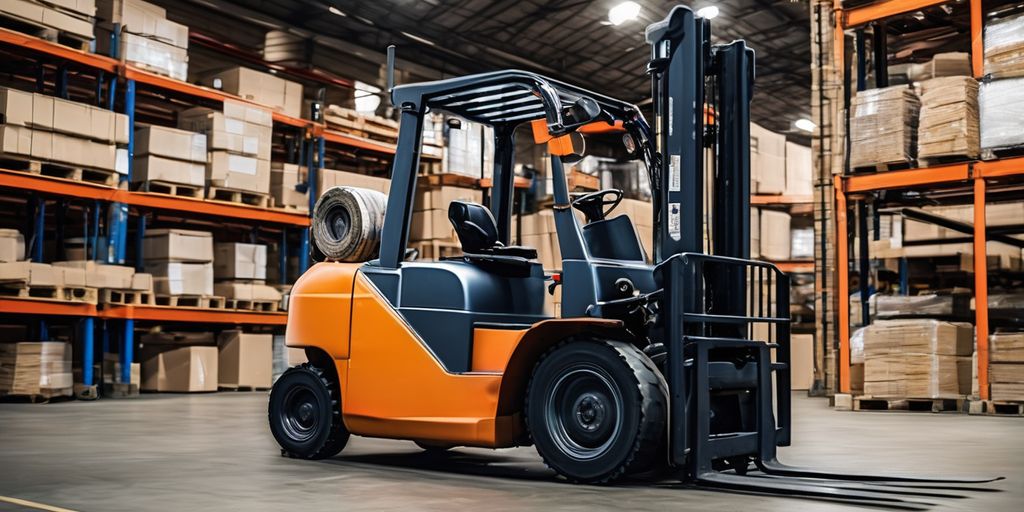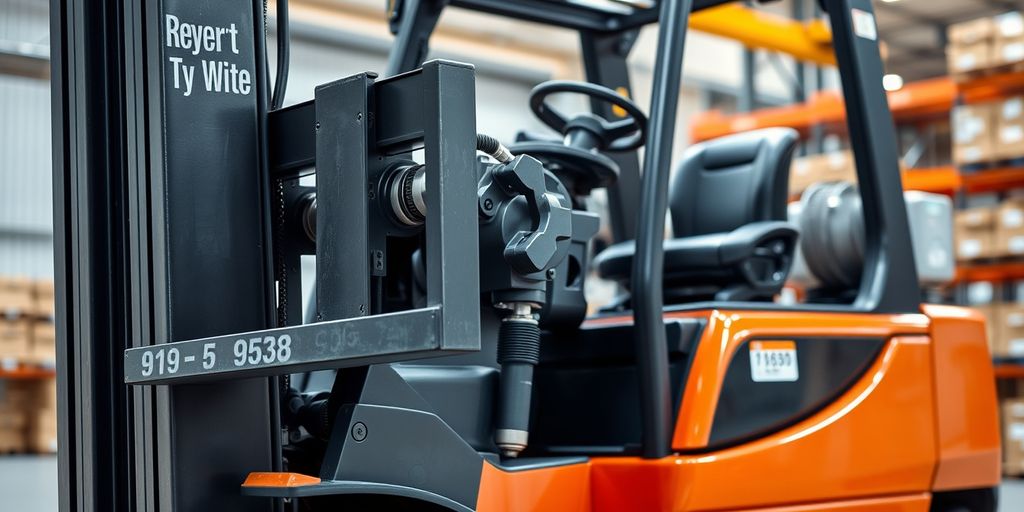Operating a forklift isn't just about moving heavy loads. It's a skill that requires proper training and certification to ensure safety and efficiency in the workplace. This article will guide you through the essentials of forklift certification, from its importance to the steps involved in getting certified.
Key Takeaways
- Forklift certification helps reduce workplace accidents and ensures legal compliance.
- To get certified, you need to meet basic requirements, complete training, and pass an exam.
- Certification training includes formal instruction, practical training, and performance evaluation.
- There are different types of certifications for various classes of forklifts, and they need to be renewed regularly.
- You can find certification programs through employers, third-party providers, or online options.
Why Forklift Certification is Essential

Reducing Workplace Accidents
Forklift certification is crucial for reducing workplace accidents. Many accidents happen because operators are careless or don't know how to use their equipment properly. Certification ensures that operators are trained to understand the risks and dangers of using a forklift. Studies show that businesses with proper training programs and daily pre-shift inspections have fewer accidents, less downtime, and lower costs.
Legal Requirements and Compliance
All forklift operators must be certified by law. The Occupational Safety and Health Administration (OSHA) requires certification before anyone can operate a forklift. This rule helps reduce injuries from unsafe forklift use. Certification can also help employers by lowering insurance costs and reducing damage to forklifts and property.
Improving Operational Efficiency
Certified forklift operators can help improve a company's efficiency. Proper training helps operators understand their equipment better, which can lead to fewer mistakes and less downtime. This means that businesses can run more smoothly and save money in the long run.
Forklift certification is not just about following the law; it's about creating a safer and more efficient workplace.
Steps to Obtain Forklift Certification
Meeting Basic Requirements
Before you start, make sure you meet the basic requirements. You need to be at least 18 years old, have good vision, and be physically able to operate a forklift safely. U.S. citizenship or lawful presence is also required.
Enrolling in Certification Training
Once you meet the basic requirements, the next step is to enroll in a certification training program. This training covers the principles of safe forklift operation, the types of forklifts used in the workplace, and general safety requirements. Training can be provided by various organizations, including employers, labor unions, and specialized training providers.
Passing the Certification Exam
After completing the training, you will need to pass a certification exam. The exam usually includes both written and practical components. You must score at least 70% on the written test and demonstrate your skills in a practical evaluation.
Receiving Hands-On Training
Finally, you will need to receive hands-on training from your employer. This training involves operating a forklift under supervision and completing an evaluation of your performance. Once you pass this evaluation, you will be officially certified to operate a forklift.
Remember, understanding OSHA regulations for forklift operations is crucial for both safety and compliance.
Components of Forklift Certification Training

Formal Instruction
Formal instruction is the first step in forklift certification training. This part of the training covers the theoretical aspects of operating a forklift. It includes classroom-style learning or online courses that teach the basics of forklift operation, safety protocols, and OSHA regulations. Topics often covered include the different types of forklifts, their uses, and the importance of forklift stability.
Practical Training
Practical training is where you get hands-on experience. This part of the training allows you to practice operating a forklift under the supervision of a qualified instructor. You'll learn how to inspect the forklift, pick up and transport loads, and perform other essential tasks. This hands-on experience is crucial for understanding the real-world applications of what you've learned in the classroom.
Performance Evaluation
The final component is the performance evaluation. In this stage, your skills are assessed to ensure you can operate a forklift safely and efficiently. The evaluation typically includes a series of tasks such as forklift inspections, picking up and putting down loads, and parking. Passing this evaluation is mandatory to receive your forklift certification.
Different Types of Forklift Certifications

Class I to Class VII Forklifts
Forklift certifications are categorized based on the type of forklift. These classes range from Class I to Class VII, each covering different types of forklifts:
- Class I: Electric motor rider trucks
- Class II: Electric motor narrow aisle trucks
- Class III: Electric motor hand trucks or hand/rider trucks
- Class IV: Internal combustion engine trucks (solid/cushion tires)
- Class V: Internal combustion engine trucks (pneumatic tires)
- Class VI: Electric and internal combustion engine tractors
- Class VII: Rough terrain forklift trucks
Specialized Certifications
In addition to the standard classes, there are specialized certifications for unique types of forklifts or specific industries. These may include certifications for operating pallet jacks, telehandlers, or other specialized equipment. Employers must ensure that operators are trained for the specific equipment they will use.
Renewal and Refresher Courses
Forklift certifications are not permanent. Operators must renew their certification periodically, typically every three years. Refresher courses are also required if an operator has been involved in an accident, observed driving unsafely, or assigned to a different type of forklift. Keeping up with these requirements ensures that operators remain competent and safe in their roles.
Finding Forklift Certification Programs
Employer-Provided Training
Many companies offer employer-provided training to ensure their workers are properly certified. This type of training is often tailored to the specific needs and equipment of the workplace. It can be a convenient option as it allows employees to train on the actual forklifts they will be using.
Third-Party Training Providers
Third-party training providers offer comprehensive forklift certification programs. These providers are often well-versed in OSHA requirements and can offer both classroom and hands-on training. Some popular third-party providers include:
- The National Forklift Foundation
- Local community colleges
- Trade schools
Online Certification Options
For those who prefer flexibility, online certification options are available. These programs allow you to complete the formal instruction portion of the training at your own pace. Some benefits of online certification include:
- 100% online courses
- Audio narration included
- Bulk discounts available
Online courses are a great way to get started, but remember that OSHA requires hands-on training and a performance evaluation to complete your certification.
Finding the right forklift certification program is crucial for building a skilled workforce and ensuring workplace safety.
Maintaining Your Forklift Certification
Certification Validity Period
Your forklift certification is valid for three years. It's important to keep track of this period to ensure you remain compliant with OSHA regulations. As the expiration date approaches, you should plan to complete the necessary steps for renewal.
Refresher Training Requirements
To maintain your certification, you must undergo refresher training at least every three years. This training helps you stay updated on safety practices and operational procedures. Refresher courses may also be required if you are involved in an accident or if your employer notices unsafe practices.
Record Keeping and Documentation
Proper record keeping is essential for maintaining your certification. Employers should keep detailed records of your training and certification status. This includes the dates of your initial certification, any refresher courses, and evaluations. Keeping these records up-to-date ensures that you are always in compliance with OSHA requirements.
Staying current with your forklift certification not only keeps you compliant with regulations but also ensures a safer workplace for everyone.
Common Questions About Forklift Certification
Age and Health Requirements
To get forklift certified, you must be at least 18 years old. There is no maximum age limit. Federal law prohibits anyone under 18 from operating a forklift. Additionally, operators must be in good health, as they need to handle the physical demands of the job.
Costs Involved
The cost of getting forklift certified can vary. Typically, it ranges from $50 to $200. This fee often includes both the training and the certification exam. Some employers may cover these costs for their employees.
Penalties for Non-Compliance
Operating a forklift without proper certification can lead to serious consequences. Employers can face hefty fines, and the business may be held liable for any accidents or injuries. Ensuring all forklift operators are certified is crucial for workplace safety and legal compliance.
It's essential to address these commonly asked questions about forklift licensure to ensure both safety and compliance in the workplace.
Conclusion
Getting forklift certified is not just a legal requirement but also a crucial step in ensuring workplace safety. By completing the necessary training and obtaining certification, operators can significantly reduce the risk of accidents and injuries. Employers benefit too, as a well-trained workforce can lead to fewer incidents, lower insurance costs, and improved productivity. Whether you're an employer looking to certify your team or an individual aiming to enhance your skills, understanding the certification process is essential. Remember, safety and compliance go hand in hand, and investing in proper training is a smart move for everyone involved.
Frequently Asked Questions
Why is forklift certification necessary?
Forklift certification is crucial to ensure that operators are trained to handle the equipment safely. This reduces the chance of accidents and injuries at work. It is also a requirement by OSHA, the Occupational Safety and Health Administration.
How can I get forklift certified?
To get forklift certified, you need to meet basic requirements such as being at least 18 years old. Then, you must enroll in a certification training program, pass a written exam, and complete hands-on training.
Are there different certifications for different types of forklifts?
Yes, there are various certifications for different classes of forklifts, ranging from Class I to Class VII. Each class pertains to different types of forklifts, such as electric motor rider trucks and rough terrain forklifts.
How long is a forklift certification valid?
A forklift certification is typically valid for three years. After that, you will need to undergo refresher training and pass an evaluation to renew your certification.
Can I get forklift certified online?
You can complete the formal instruction part of the certification online. However, OSHA requires hands-on training and a performance evaluation to be done in person.
What are the penalties for not having forklift certification?
Operating a forklift without proper certification can lead to hefty fines and penalties from OSHA. It also increases the risk of workplace accidents, which can result in injuries or even fatalities.




Leave a comment
This site is protected by hCaptcha and the hCaptcha Privacy Policy and Terms of Service apply.